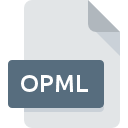.OPML File Extension

Outline Processor Markup Language File
| Developer | The Omni Group |
| Popularity | |
| Category | Web Files |
| Format | .OPML |
| Cross Platform | Update Soon |
What is an OPML file?
The .OPML file extension stands for Outline Processor Markup Language. It is used to represent hierarchical information in a structured format, often for outlines and lists. It is primarily used for organizing and sharing outline data across various applications.
More Information.
The initial purpose of OPML was to facilitate the exchange of outline data, which can be used for tasks such as managing RSS feeds, project planning, and organizing information. The format was designed to be simple and human-readable, making it easy to edit and integrate with various applications.
Origin Of This File.
OPML was developed by Dave Winer and released in 2000. It is based on XML (eXtensible Markup Language) and was created to standardize the format for outlines that could be shared and used across different software tools.
File Structure Technical Specification.
- Format: XML-based
- Structure: OPML files are structured as XML documents with nested
<outline>elements representing hierarchical data. Each<outline>element can have attributes such as text, type, and other metadata.
How to Convert the File?
Windows:
- Using Conversion Tools:
- Using Text Editors and Scripting:
- Text Editors: Open the OPML file in a text editor (e.g., Notepad++). Copy the content and manually convert it into a different format if needed.
- Custom Scripts: Use a scripting language (e.g., Python) with libraries such as
xml.etree.ElementTreeto parse OPML and convert it to another format.
Linux:
- Using Conversion Tools:
- Online Converters: Similar to Windows, online services like Convertio can be used.
- Command-Line Tools: Use command-line tools like
xmlstarletfor processing XML files. Write scripts to transform OPML into other formats.
- Using Text Editors and Scripting:
- Text Editors: Open the file in editors like
geditorvim, and manually convert or save in another format. - Custom Scripts: Write scripts using languages like Python or Perl to process the OPML file and export to your desired format.
- Text Editors: Open the file in editors like
MAC:
- Using Conversion Tools:
- Using Text Editors and Scripting:
- Text Editors: Use text editors such as TextEdit or BBEdit to open the file and manually save or convert it.
- Custom Scripts: Use scripting languages (e.g., Python) to parse and convert OPML content to other formats.
Android:
- Using Apps:
- OPML Reader Apps: Some apps like SimpleMind or MindMeister can open OPML files and export them to other formats like TXT or PDF.
- Document Editors: Apps such as QuickEdit or Jota+ can be used to open and manually convert OPML content if export options are not available.
- Online Converters:
- Use mobile browsers to access online converters like Convertio and upload the OPML file for conversion.
iOS:
- Using Apps:
- Outliner and Mind Mapping Apps: Apps like MindNode or Outline can open OPML files and export to various formats like TXT or PDF.
- Document Editors: Use apps like Textastic or iA Writer to open and manually convert OPML files.
- Online Converters:
- Use Safari or other browsers to access online conversion tools like Convertio to upload and convert the OPML file.
Others:
- Online Converters:
- Custom Solutions:
- APIs and Libraries: Use APIs or libraries (e.g., for Python, Ruby) to write custom conversion scripts. These can be hosted on cloud platforms or run locally on servers.
Advantages And Disadvantages.
Advantages:
- Standardized Format: Provides a consistent way to represent and share hierarchical data.
- Human-Readable: XML format is easy to read and edit with text editors.
- Interoperability: Supported by various applications and tools for outlines and RSS feeds.
Disadvantages:
- Complexity: For very large outlines, the XML format can become cumbersome and hard to manage.
- Limited Data Types: Primarily suited for hierarchical data, and may not be ideal for more complex data structures.
How to Open OPML?
Open In Windows
- Text Editors: Notepad++, Sublime Text
- Outliner Tools: FreeMind, OmniOutliner (via plugins or import features)
- RSS Readers: Feedly, RSSOwl
Open In Linux
- Text Editors: Gedit, Kate
- Outliner Tools: Org-mode (Emacs), other XML-compatible editors
- RSS Readers: Liferea, Akregator
Open In MAC
- Text Editors: TextEdit, BBEdit
- Outliner Tools: OmniOutliner, iOutliner
- RSS Readers: NetNewsWire, Reeder
Open In Android
- Text Editors: QuickEdit, Jota+
- Outliner Tools: SimpleMind, MindMeister
Open In IOS
- Text Editors: Textastic, iA Writer
- Outliner Tools: MindNode, Outline
Open in Others
Online Tools: Various online OPML viewers and editors can be used to open and edit OPML files directly in a web browser.













